Less violence, more tariffs and the 11-year-old Ayotzinapa case: Friday’s mañanera recapped
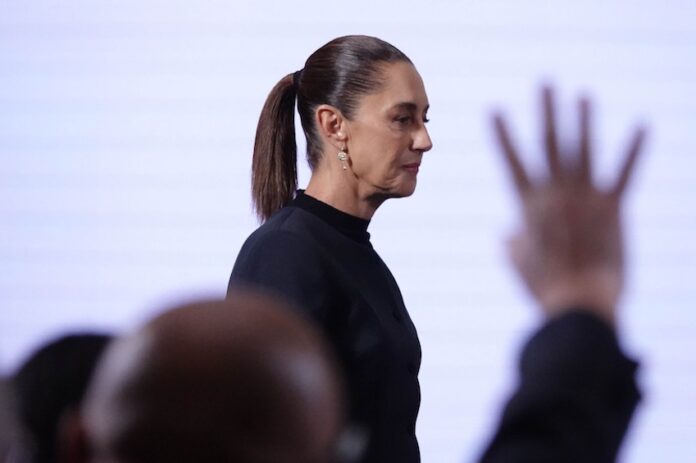
Murders, tariffs, Mexico’s relationship with China and the 11-year-old Ayotzinapa case involving the disappearance of 43 students were among the topics President Claudia Sheinbaum spoke about at her Friday morning press conference.
Later on Friday, Sheinbaum traveled to Ciudad Juárez, Chihuahua, where she delivered yet another speech on her nationwide “accountability tour.”
Thursday was Mexico’s least violent day in years
Just before the end of her mañanera, Sheinbaum acknowledged that 37 homicides were recorded on Thursday.
“Yesterday was the lowest number of homicides for at least 10 years, I think,” she said before conceding that she wasn’t sure that Thursday was actually the least violent day in a decade.
“Let us know,” Sheinbaum said.
In fact, the murder count on Thursday was the lowest number of homicides on a single day in Mexico since December 2018, or almost seven years, according to media reports. Twelve of Mexico’s 32 federal entities reported no homicides on Thursday, while Guanajuato recorded the highest number with six.
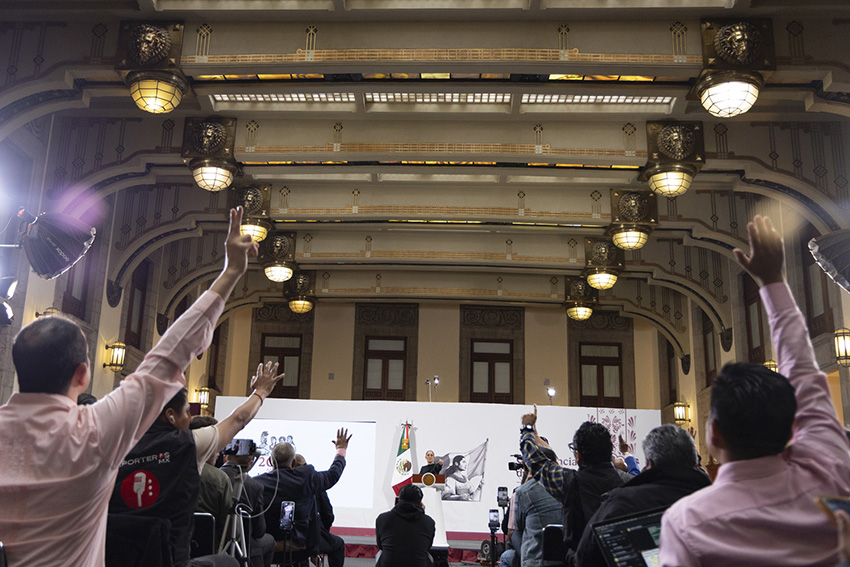
(Juan Carlos Buenrostro / Presidencia)
Sheinbaum played down the importance of the (comparably) low number of homicides on Thursday, a figure 46% below the daily average in the first eight months of 2025.
She indicated that she was more interested in seeing the homicide data for the entire month of September, before noting that the number of murders in August was 32% lower than September 2024, the last month of Andrés Manuel López Obrador’s presidency.
In the first eight months of 2025, the average daily homicide rate was almost 25% lower than the daily average during 2024.
Sheinbaum has attributed the decline in homicides to the effectiveness of her government’s security strategy. On Friday morning, she said that “this idea” that not all homicides are being reported by the federal government is “false.”
‘We have very good relations with China,’ and tariffs are ‘a matter of strengthening our economy’
Sheinbaum noted that Economy Minister Marcelo Ebrard met on Thursday with China’s ambassador to Mexico.
The meeting took place two weeks after the president sent a proposal to Congress to implement tariffs of up to 50% on a wide range of goods from China and other countries with which Mexico doesn’t have trade agreements. This week, China’s Commerce Ministry initiated an investigation into the higher tariffs Mexico intends to implement.
Sheinbaum said that her government is proposing “high-level” talks with China on the issue, but she didn’t indicate any willingness to consider easing the proposed duties.
“Why was this decision taken? In [a period of] about four years, imports to our country [from China] increased by nearly 83% and [our] exports also increased. And what we want, … [with] Plan México, is to produce more in Mexico in order to have a trade balance where imports are not equal to exports,” she said, explaining that the goal is to maintain an overall trade surplus.
“At the moment we have a positive balance of trade,” Sheinbaum said before noting that the surplus is only “small.”
“… We want it to be bigger,” she said.
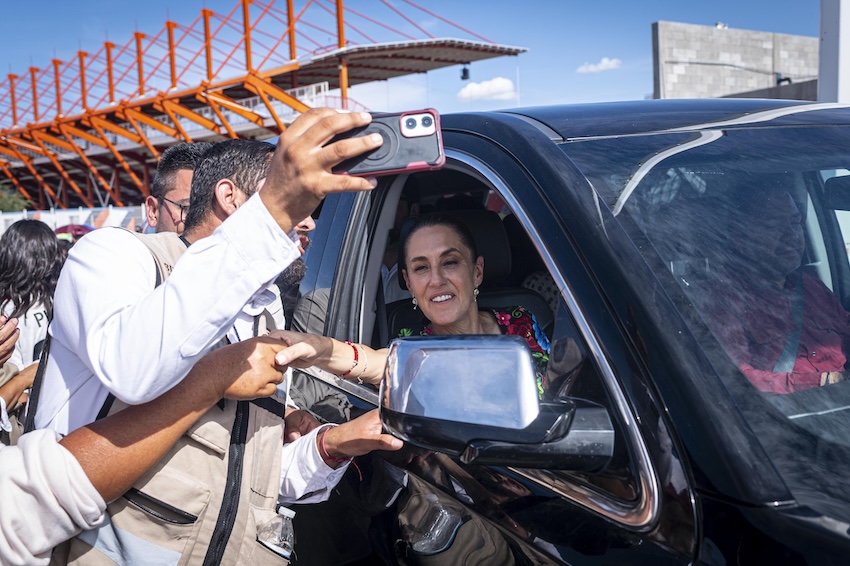
“… And that is the objective of the [proposed] tariffs,” Sheinbaum said, asserting that they are not specifically targeted at China as they will apply to all countries with which Mexico doesn’t have trade agreements.
“Obviously we’re interested in having dialogue [with those countries],” she said, adding that her government wants China to “understand” Mexico’s “situation.”
China has asserted that Mexico is acting “under coercion” from the United States “to constrain China,” but Mexican officials say that the primary goals of the proposed tariffs are to protect Mexican industry and reduce reliance on imports.
However, Mexico has faced pressure from the United States, and Canada, over its trade relationship with China as well as growing Chinese investment here. The decision to impose higher tariffs on imports from China, along with some other government measures and certain remarks by Mexican officials, indicate that Mexico is indeed yielding to that pressure — at least to some extent — ahead of the 2026 review of the USMCA free trade pact.
Despite Mexico’s less than uber-friendly attitude toward the East Asian economic powerhouse, Sheinbaum asserted on Friday that “we have very good relations with China.”
The decision to impose new tariffs on imports from that country and others is simply “a matter of strengthening our economy,” she said.
Sheinbaum restates her commitment to ‘truth and justice’ in Ayotzinapa case
On the 11th anniversary of the disappearance of 43 teachers’ college students in Guerrero, Sheinbaum reiterated her commitment to finding the “truth” and achieving “justice” in the unresolved case.
“We’re working on that,” she said. “There is a new special prosecutor. We have meetings with the families, with the mothers and fathers of the Ayotzinapa students.”
“Our commitment is to do everything in our power to reach the truth and justice, and to find the young men,” Sheinbaum said.
The remains of just three of the 43 students have been found. The young men were abducted in Iguala, Guerrero, on Sept. 26, 2014, and presumably killed some time after that.
The case — in which the army, municipal police and a crime gang called Guerreros Unidos were allegedly involved — shocked Mexico and triggered huge protests against the government of then-president Enrique Peña Nieto.
By Mexico News Daily chief staff writer Peter Davies ([email protected])
11 years after the Ayotzinapa mass kidnapping, protesters demand answers in Mexico City ‘mega-march’
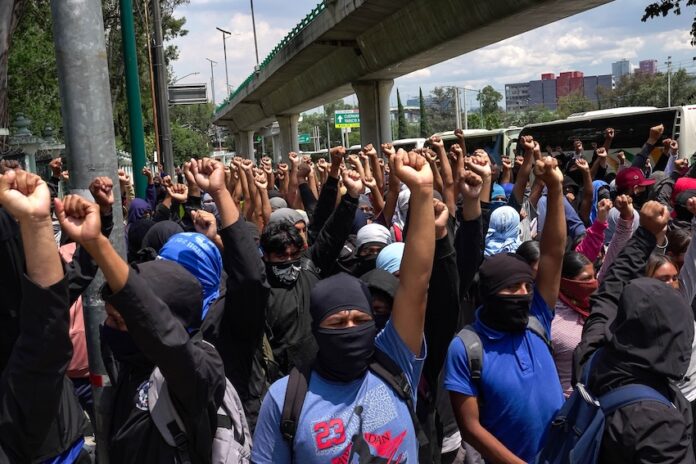
Mexico City authorities braced for potential violence ahead of Friday’s “mega-march” commemorating the 11th anniversary of the disappearance of 43 students from the Ayotzinapa Rural Teachers’ College in Guerrero.
The march’s planned route follows 4.2 kilometers from the Angel of Independence Monument on Paseo de la Reforma Avenue to the National Palace, which was sealed off with metal fences. Roughly 3,000 protesters are expected to attend, the publication Milenio reported. As of 5 p.m. local time, no attendance estimates were available.
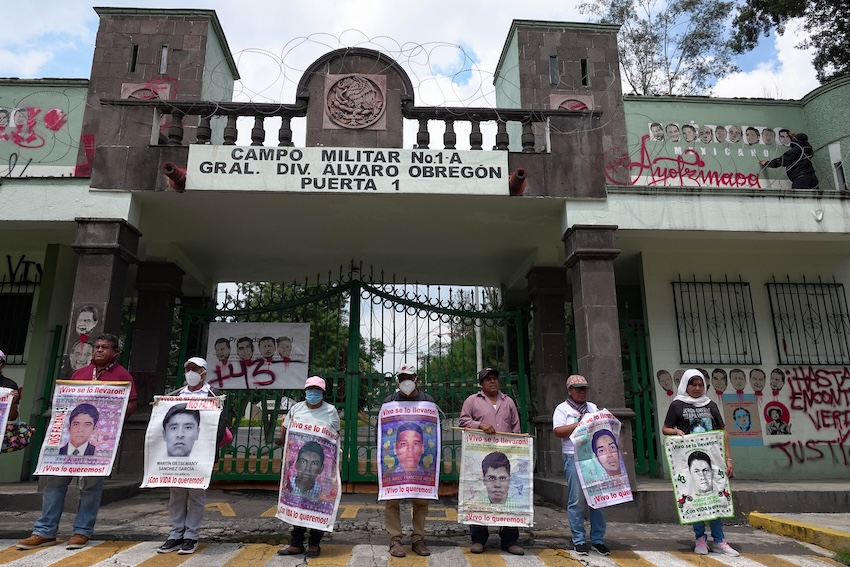
In addition to demanding justice for the 43, this week’s demonstrations aim to highlight other forced disappearances and human rights violations that continue to occur in the country.
Other rallies took place on Friday morning, prompting city authorities to close off downtown streets, shutter federal ministries and protect historic structures in hopes of discouraging violence.
President Claudia Sheinbaum met with parents of the missing students on Sept. 4, but the families left the meeting disappointed, insisting that far from progress in the case, there was regression.
Sheinbaum created a new investigative unit to review the still unresolved case in March, but has little to show for it.
“We’re working on it,” she said Friday morning. “There’s a new special prosecutor … and we’re committed to doing everything possible to uncover the truth and provide justice.”
Even as Sheinbaum reiterated her promise to provide “truth and justice” to family members of the “disappeared,” she condemned Thursday’s violence at a notorious military installation in Mexico City.
Ayotizinapa protesters had gathered at the Campo Militar No. 1 in western Mexico City as part of the mobilizations organized ahead of Friday’s mega-march.
“We do not condone violence,” she said. “We are not going to be provoked into repressive action, but we do not agree with actions like we saw yesterday.”
The military base was a clandestine prison during the “Dirty War” of the 1970s and students detained there after the 1968 protests were tortured at the camp.
On Wednesday, another demonstration was held outside the Foreign Relations Ministry (SRE) building.
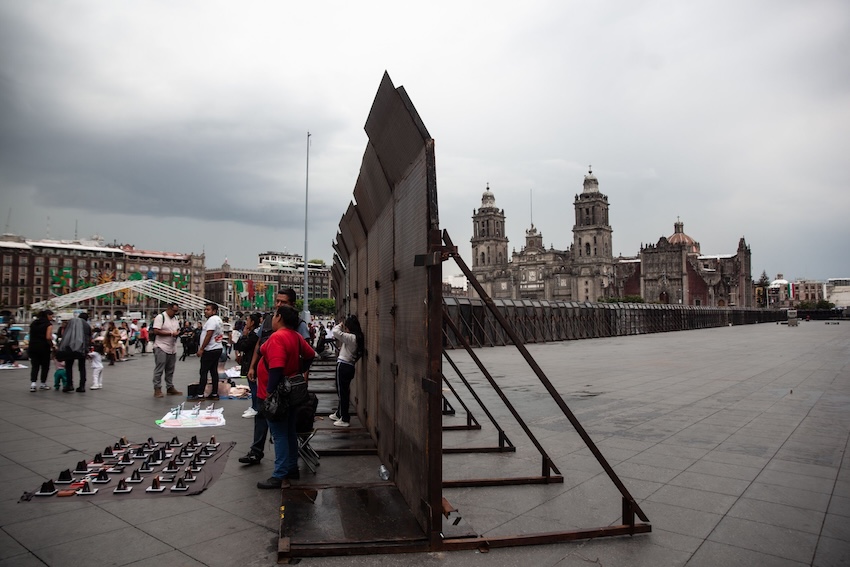
Students from the teachers’ college carried posters featuring the faces of their missing schoolmates while shouting slogans demanding justice. They also demanded that the SRE take action to repatriate suspects who fled abroad.
One such suspect, Tomás Zerón, has taken refuge in Israel. The country has refused to extradite him despite pleas from Sheinbaum to return him to Mexico. Zerón, the director of the Criminal Investigation Agency from 2013-2016, faces accusations of abduction, torture and tampering with evidence related to the Ayotzinapa case.
Thursday’s protest at the military installation turned violent when students crashed a cargo truck against the main gate in an effort to gain entry. When that failed, they set the truck ablaze and tossed fireworks at the wall.
Earlier, parents of the 43 “disappeared” young men led a rally outside the military camp, calling on the Federal Attorney General’s Office (FGR) to follow lines of investigation implicating military personnel.
The families of the disappeared continue to believe the military was involved in the Ayotzinapa case — either by omission or commission — and are frustrated over the arrest and release of suspects, including military personnel, that have beleaguered the investigation.
The protesters also reiterated their demand that the Army hand over hundreds of pages of so-called classified documents that allegedly contain information about the tragic incident in Iguala, Guerrero.
Sheinbaum has the authority to order the military to release the documents, but she has said that the Army already turned over all relevant information. However, members of an Inter-American Commission on Human Rights team that investigated the incident insist otherwise.
With reports from El Sol de México, Milenio, N+, Sin Embargo and Infobae
Central bank cuts interest rate to 7.5%, lowest since May 2022
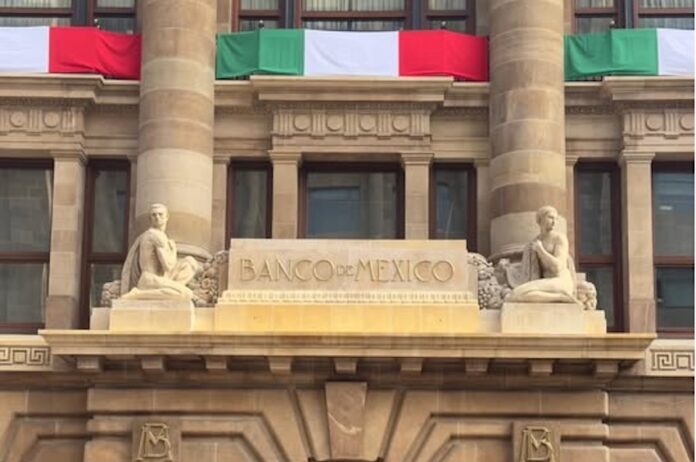
For the 10th consecutive meeting, Mexico’s central bank (Banxico) lowered its benchmark interest rate on Thursday, reducing it by 25 basis points to its lowest level since May 2022.
In a 4–1 vote, Banxico’s monetary policy committee reduced the overnight interbank interest rate to 7.5%, following a rate cut of the same amount by the US Federal Reserve on Sept. 17.

The reduction was approved, Banxico noted, while “economic activity exhibited sluggishness at the beginning of the third quarter of 2025” amid ongoing concerns about global trade tensions.
Banxico faces the twin tasks of reducing inflation and stimulating the economy amid weak economic growth, while also factoring fluctuating global trade policies into the equation.
The concern is that while a monetary easing policy could spur the economy, it could also fuel inflation in Latin America’s second largest economy.
Headline inflation crept up to 3.57% in August from 3.51% in July and data released on Wednesday showed that annual core inflation — which has been rising in recent months — hit 4.26% in the first half of September.
Headline inflation — which also rose during the first two weeks of September — reflects price changes for all goods and services, while core inflation excludes volatile items like food and energy to show the underlying, longer-term inflation trend.
The news agency Reuters interpreted Thursday’s decision to reduce the interest rate by a quarter-point — instead of the half-point reduction that Banxico had decided on four times earlier this year — as an indication that the bank has “concerns about sticky inflation, particularly the closely-watched core index.”
Further demonstrating this concern in an updated inflation forecast released on Thursday, Banxico raised its estimate for year-end annual core inflation to 4.0% in the fourth quarter, up from its previous estimate of 3.7%.
While expressing unease that Banxico might be overlooking persistent core inflation pressures, Alberto Ramos, managing director at Goldman Sachs, said in a note to clients that he expects two more rate cuts of 25 basis points before the end of the year.
Gabriela Siller, head of analysis at Banco Base in Mexico City, concurred, saying in a post on X that “it is noteworthy that [Banxico’s] forward guidance remains unchanged, implying that the governing board remains open to further interest rate cuts.”
Banxico has two more meetings on its 2025 calendar (Nov. 6 and Dec. 18), which suggests the interest rate could finish the year at 7%.
With reports from El Financiero, Trading Economics and Reuters
New US tariff threatens Mexico’s automotive industry starting Oct. 1

Another tariff threat hangs over Mexico’s automotive after U.S. President Donald Trump on Thursday announced a 25% tariff on heavy truck imports. The measure, set to go into effect Oct. 1, will have a significant impact on Mexico unless some or all Mexican products receive exemptions based on the USMCA free trade agreement.
It is unclear, however, if the duties will apply to Canada- or Mexico-made trucks that are compliant with the United States-Mexico-Canada Agreement (USMCA). Without that exemption, Mexico will be severely affected.
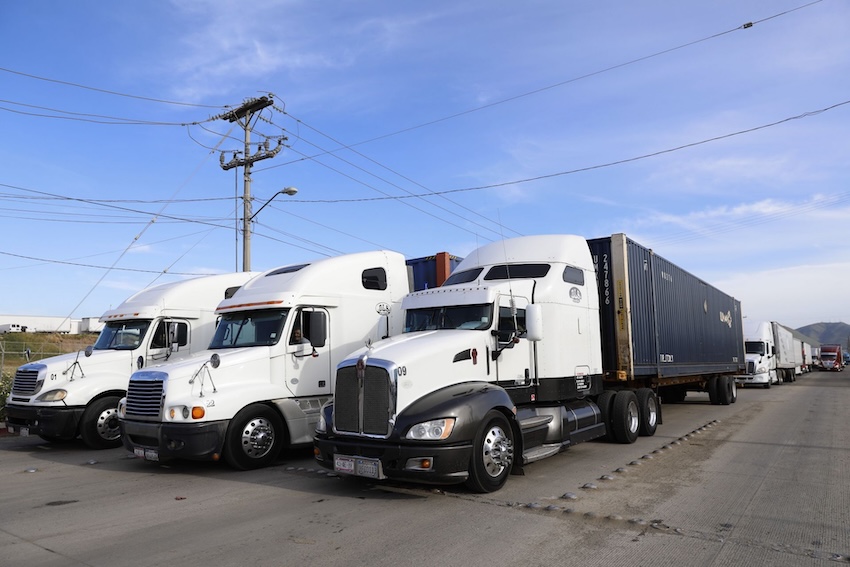
Mexico was the largest exporter of medium- and heavy-duty trucks to the U.S. last year (78% of the market), followed by Canada, Japan, Germany and Turkey, according to the International Trade Administration.
Claiming the sweeping new tariffs are designed to protect U.S. manufacturing and national security, Trump said they also include 100% duties on branded drugs and 30% levies on furniture.
Mexico is home to 14 manufacturers and assemblers of buses, trucks and tractor trucks, and two manufacturers of engines, NBC News reported. It is also the leading global exporter of tractor trucks, 95% of which are destined for the United States.
Juan Carlos Baker, CEO of Ansley Consultants, told transportation industry publication T21 that the immediate effect is that Mexican trucks and tractor-trailers will be more expensive when exported to the United States, though the direct impact on competitiveness and future investments remains to be seen.
Tariffs would likely affect Chrysler-parent Stellantis, which produces its popular heavy-duty Ram trucks as well as commercial vans in Mexico. Sweden’s Volvo Group is building a US $700 million heavy-truck factory in Monterrey that is set to start operations in 2026.
Trump said the new tariff on heavy trucks imported into the United States is designed to level the playing field for the U.S. truck-making industry which has suffered “from the onslaught of external disruptions” and “unfair foreign competition.”
CNN reported that U.S. truckmakers have been hit relentlessly by the White House’s compounding tariff.
Steel and aluminum tariffs applied in June have raised the price of all metals — both imported and domestic. As a result, some U.S.-built trucks are more costly than trucks made by foreign manufacturers.
Thursday’s announcement came about after a U.S. Commerce Department (DOC) investigation which Trump ordered to determine whether medium-duty and heavy-duty truck imports pose a national security threat.
Mexico voiced opposition to the investigation, telling the DOC in May that all Mexican trucks exported to the United States have on average 50% U.S. content, including diesel engines.

Trump insisted the tariffs will protect the U.S. truck-making industry, adding that “we need our truckers to be financially sound and healthy, for many reasons, but above all, for national security.”
The U.S. Chamber of Commerce questioned that claim, saying that imports of commercial trucks and parts used in their manufacture are sourced overwhelmingly from U.S. allies, “posing no threat to U.S. national security.”
The Chamber said manufacturers should not be penalized with tariffs on imports from Mexico and Canada after making significant investments and adjustments to overcome [supply chain] challenges.
Last year, the United States imported almost US $128 billion in heavy vehicle parts from Mexico, accounting for approximately 28% of total U.S. imports, Mexico said.
Truck sales in the U.S. have been sluggish for most of the year, however.
The U.S. imported US $32.41 billion worth of trucks, buses and special-purpose vehicles from around the world from January to July 2025, a 15.4% decrease compared to the same period in 2024.
Mexico dominated those shipments, exporting US $25.86 billion, a year-over-year decrease of 13.8%, according to data from the DOC.
With reports from El Economista, T21, CNN, Reuters, NBC News, Freight Waves and BBC
Meet Clutch, Maple and Zayu, the 2026 FIFA World Cup mascots

More than seven years after Mexico, the U.S. and Canada were jointly awarded the 2026 FIFA World Cup, the mascots for each country have been revealed — and the roar you hear coming from Mexico is that of Zayu the Jaguar.
FIFA, the world governing body of soccer, announced this week that Zayu will join Clutch the Bald Eagle (United States) and Maple the Moose (Canada) in representing the three host countries.
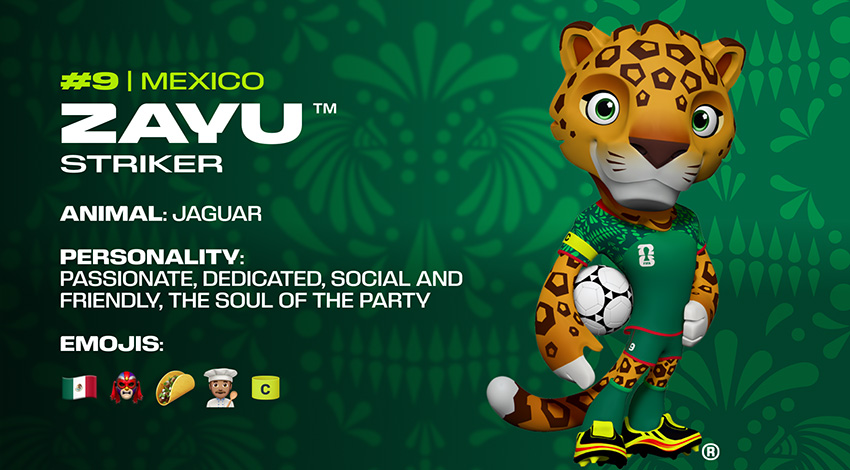
The world’s premier men’s soccer tournament will kick off June 11, 2026 at Mexico City’s Aztec Stadium, renamed as Estadio Banorte in a funding deal. There will be five games in Mexico City, four in Monterrey and four in Zapopan (adjacent to Guadalajara).
Each of the mascots is meant to symbolize national pride, but perhaps the quickest to win over its public — as evidenced by social media engagement and news coverage — is Zayu.
The stocky, smiling jaguar wears Mexico’s green jersey and the number 9.
FIFA says he is “from the jungles of southern Mexico” and that he “embodies the rich heritage and vibrant spirit of the country.” The name Zayu is “inspired by unity, strength and joy.”
Added FIFA President Gianni Infantino: “Maple, Zayu and Clutch convey joy, excitement and the spirit of togetherness that defines the FIFA World Cup. I can already imagine them on children’s jerseys, high-fiving football legends, and, for the first time, starring in video games that millions will enjoy.”
They will be the first mascots to be incorporated as interactive characters in FIFA Heroes, a video game for Nintendo, PlayStation, Xbox and other platforms due out next year.
While officials did not specify a precise linguistic root for Zayu’s name, some Mexican scholars have noted its similarities with Indigenous words such as “Dzahui,” the Mixtec term for rain.
One pro team in Mexico, the Jaguares de Chiapas, celebrated the resemblance between Zaya and its old mascot, Balam, with a posting on Facebook.
Balam was the Jaguares’ mascot from 2002 to 2013 when they played in Mexico’s top-tier Liga MX. The team from the Chiapas capital of Tuxtla Gutiérrez now competes in Liga Premier, Mexico’s third division.
The jaguar has long been a sacred figure in Mexican history: revered by the Maya as a symbol of power and courage, appearing across art and mythology, and still present today as a powerful emblem of southern Mexico.
Mexico’s Ministry of Tourism emphasized that Zayu was selected not merely as a sports figure, but as a cultural bridge carrying centuries of heritage.
This marks the fourth time a feline has served as a World Cup mascot: Spain’s León Willie in 1966, Germany’s Goleo VI in 2006 and Zakumi the leopard in South Africa 2010.
The mascot at the last men’s World Cup, in 2022 in Qatar, was named La’eeb, which means “super-skilled player.” It was supposed to be an animated version of a traditional Arabic headdress, but most people saw it as a ghost.
FIFA bills Zayu as forward, while Canada’s Maple is cast as goalkeeper and Clutch as a midfielder.
Mexican President Claudia Sheinbaum, who was recently presented with the very first 2026 World Cup ticket — which she said she’ll give away, likely to a young girl from a family of meager means who loves soccer — talked over the summer about Mexico’s preparations for the upcoming tournament.
And similar types of stories — including future mascots — won’t be stopping any time soon, as Mexico is expected to co-host the 2031 Women’s World Cup along with the U.S., despite no official announcement yet from FIFA.
With reports from El Universal, Récord, ESPN México and The Athletic
Cancún and Riviera Maya dominate hotel construction in Mexico with over 90% of new rooms this year
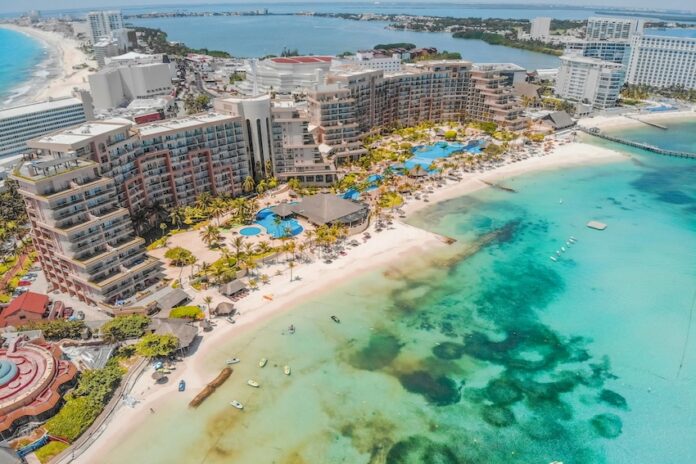
Cancún and the Riviera Maya have established themselves as the main drivers of Mexico’s hotel industry through 2025, leading the construction and expansion of hotels and accommodations nationwide.
According to a new report from commercial real estate firm CBRE, Cancún and other areas of the Riviera Maya added 2,070 new rooms between January and May, accounting for 91% of the national inventory. In other words, nine out of every 10 new hotel rooms that have opened in Mexico this year opened in that region.
In the first five months of the year, 2,280 new hotel rooms were built in Mexico. Of that total, 1,715 rooms (75%) opened in Cancún while 355 (16%) opened in the Riviera Maya.
“These results show that, despite current challenges, Cancún and the Riviera Maya continue to establish themselves as strategic destinations for hotel and tourism investment in Mexico,” Christian Lega, vice president of hospitality at CBRE Mexico said.
Meanwhile, Andrés Martínez Reynoso, head of the Quintana Roo Tourism Promotion Council (CPTQ), said the state is close to matching Las Vegas in number of hotel rooms.
“We have more than 130,000 rooms. We are 20,000 rooms away from reaching the hotel capacity of Las Vegas. With the new hotels, the airport and the Maya Train, which will connect three international airports, we are facing a completely different change,” Martínez said.
After Cancún and the Riviera Maya, Riviera Nayarit comes next in the opening of new rooms, with 140 (6%) between January and May.
In the report, CBRE estimates that more than 3,900 new rooms will come into operation across Mexico during the second half of 2025.
Trends in the hotel and travel industry
According to CBRE, investment in resorts continues to be the most attractive alternative for investors, as growing demand has driven this type of development in both established destinations and emerging markets like Mexico.
“Mexico has established itself as a key destination, with multiple luxury brands expanding their presence,” the report says.
Currently, Cancún, Riviera Maya and Los Cabos have more than 5,000 rooms under construction, which could be released to the market between 2025 and 2027.
As for hotel occupancy, the Tourism Ministry reported that the average hotel occupancy rate in the 70 monitored tourist destinations was 58.7% between January and April, with Cancún and Los Cabos leading the way in arrival of international tourists.
Mexico News Daily
Casa Roja, a new Frida Kahlo museum focused on her family life, opens in Mexico City

Museo Casa Kahlo, also called Casa Roja (Red House), has opened its doors as a museum in Mexico City, offering a new window into Frida Kahlo’s intimate and family life beyond what the familiar Casa Azul (Blue House) depicts.
The museum, located just steps away from Casa Azul in the Coyoacán neighborhood, was originally the home of Frida Kahlo’s parents and later of her sister Cristina. Until just two years ago, direct descendants of the Kahlo family lived there, where they catalogued and preserved personal belongings before turning the property into a museum.
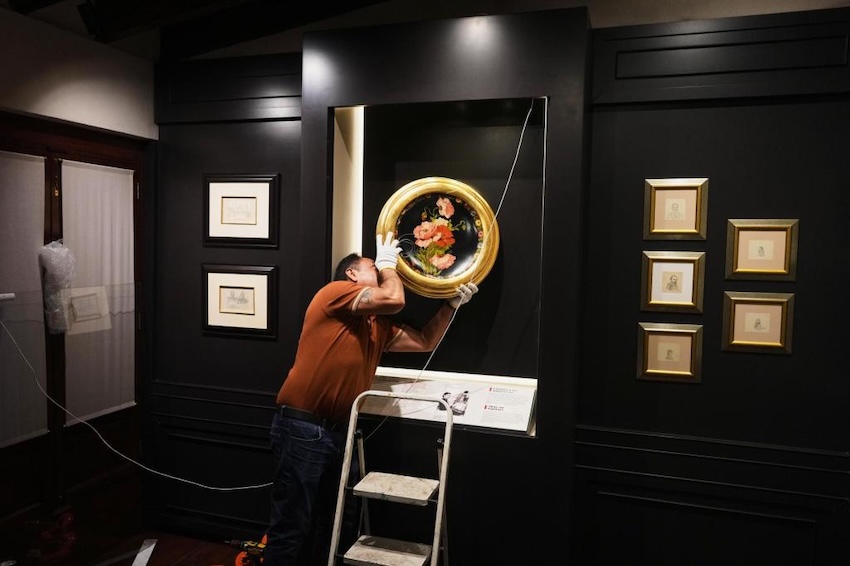
The new museum intends to broaden Kahlo’s image beyond her art and mythologized fame by revealing intimate details about her close-knit family.
According to Kahlo’s great-niece María Romero Kahlo, who took the Associated Press on a tour, the family decided to paint the house red and keep it that way over the years, because, she said, it symbolizes “the heart of the Kahlo family.”
“You can find a more human approach to her story, to her origins,” the museum director Adán García said, adding that visitors will see that behind the great artist was a child who “struggled with polio and who was fond of her father and her mother.”
To get a sense of Kahlo’s private life, visitors will see extensive correspondence between Frida and her family, including her sister and caregiver Cristina, whom Frida has described as the other half of her heart.
Casa Roja also displays the work of her father, Guillermo Kahlo, a professional photographer. Visitors learn about his arrival in Mexico from his native Germany, as well as details about his first marriage, his two daughters, and how he met Frida’s’s mother, Matilde Calderón.
Personal items like jewelry pieces worn by Kahlo in pictures, embroidered dresses, her paint brushes and even a microscope the artist used as a child to find insects, are displayed throughout the house.
The exhibition also offers glimpses of the young Frida Kahlo’s artistic awakening, including the embroidery of a small house she completed when she was five, drawings of distant landscapes copied from postcards, and what is thought to be the only murals painted by the artist.
According to María Romero Kahlo, visitors to the museum will discover “the real Frida. The one who cried, who laughed, who shared secrets with her sisters — and these walls will reveal some of them.”
The museum is open Wednesday through Monday, from 9 a.m. to 7 p.m.
With reports from The Associated Press and El País
Memoirs of a Kyoto Taquería: My Japanese carnitas adventure
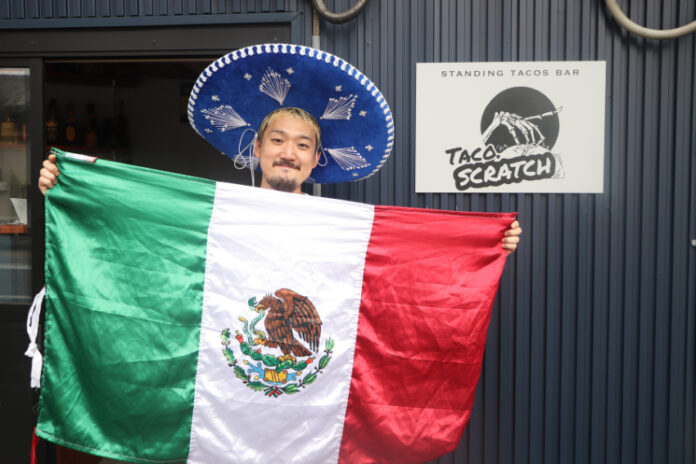
A few days ago, I was in Kyoto, the ancient capital of Japan. The last thing I imagined was that I would be tucking into some delicious tacos made by a local chef.
When you get to know another country, you want to taste the local cuisine to discover new flavors, especially in Japan, which is known for its rich and varied gastronomy. So, when I traveled to the country for the first time with some friends. I was excited to try everything, from the weirdest and most exotic things I could find at 7-Eleven, to the most traditional dishes in little restaurants where only locals go.
How I found a taquería in Kyoto, Japan
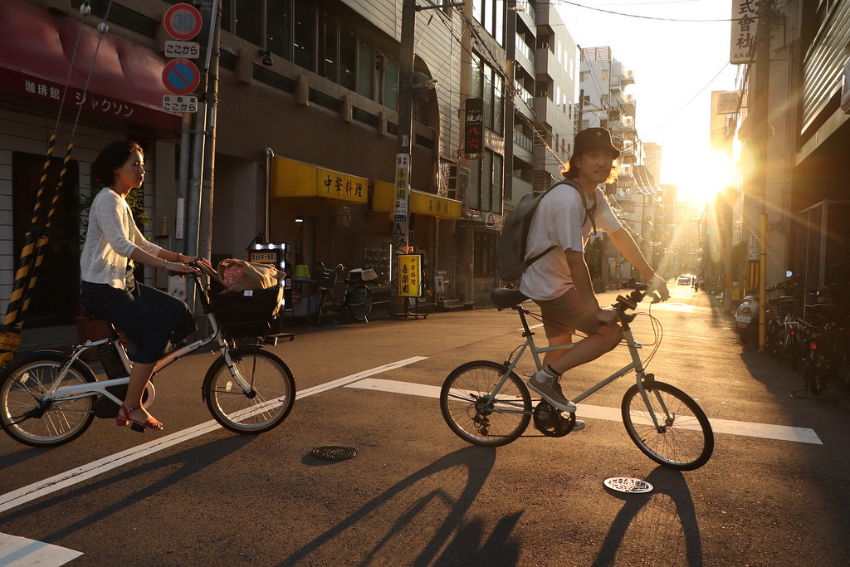
When I travel, rather than following a map, I like to follow my instincts and let myself wander through streets that look charming and photogenic to my photographer’s eyes; that’s how I often stumble upon tourist spots “by accident.” Also, I don’t like to follow the typical visitor’s route. I prefer to feel like a local and walk around places where tourists normally wouldn’t go. While I was in Kyoto, I left my hotel without a fixed plan, simply choosing the direction where most of the pretty things to see seemed to be and started walking.
A few kilometers later, I crossed the street and something caught my eye: some foreign guys were staring at a sign. I peeked to see what it said, and to my surprise, it turned out to be a Mexican taco stand. Of course, I decided to go in, partly because I was missing Mexican food a little — which, let’s be honest, as Mexicans we always do, even if we’re away from home for just two days — and partly out of curiosity to see if the tacos would be as good as in Mexico, or a disappointment. At that moment, I felt like the official judge in charge of giving a verdict on behalf of the entire country.
The story behind Keita’s taquería
When I entered, I ordered three tacos: one carnitas and two steak. The place was small, with just a counter, a bathroom and a kitchen — no chairs — just like tacos are eaten in Mexico: standing up. Since it was such a small space and because it was just me and the taquero, conversation flowed easily. As soon as I ordered my tacos, I pulled out a 100-peso bill, showed it to him and said: “I’m Mexican.” He was pleasantly surprised and delighted that a Mexican had come to his place to try his tacos. I was even more surprised to watch this Japanese man, Keita, prepare those delicious tacos with such enthusiasm and care: first placing the tortilla on an elegant black plate, then the freshly grilled meat, a handful of diced purple onion, followed by cilantro, guacamole and finally the essential squeeze of lime.
While he prepared the tacos, we chatted a bit and he told me his story. In 2018, he went on a student exchange program to La Paz, Baja California Sur, for three months. Every day of his stay in Mexico, he tried tacos of different kinds. He was so captivated by the taste that when he returned to Japan a couple of years later, he decided to open his own taquería.
Where the ingredients come from
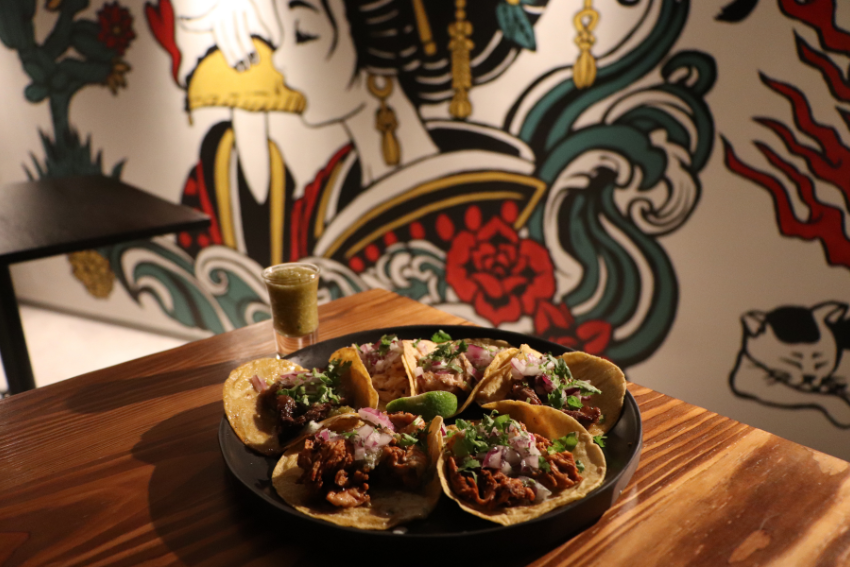
Keita makes his own tortillas — he only buys the masa online, which costs about ¥1242 (154 pesos, or US $8.40) on Rakuten Market. They even sell blue corn masa there. At first, he used to visit Mexican restaurants and ask chefs how tortillas were made; he also researched online. For four and a half years, since opening his place in Fukushima, he has been perfecting the process until developing his own original recipe. I must say the tortilla was delicious, with the perfect thickness, color and size — much better than the pale tortillas you usually find in other countries.
As for the other ingredients, like onion, meat, avocado and lime, he buys them at his local market. This didn’t surprise me, since Japan has a great variety of fresh fruits and vegetables. The salsa he makes is green, using tomatillos and serrano chiles, which he can also easily find in specialty stores.
The tacos looked amazing, enticing from the very first glance, as good as any you’d find in a taquería in Mexico. The moment I took the first bite, I was amazed by the flavor and even though the salsa wasn’t very spicy, the whole ensemble was an homage to the Mexican taco. I was even more surprised to discover that Keita also made the carnitas himself. I felt so happy to taste them, not feeling disappointed at all, but rather amazed that Japanese hands could create something so faithful to Mexico.
A cultural exchange over tacos
As I ate, we kept talking about his fascination with Mexico, and he noticed my fascination with Japan as I told him I was trying to learn to write hiragana and katakana. It turned into a very interesting cultural exchange. I showed him what I had learned, and he taught me other things, like how to write numbers, how to say thanks, and how to write my name in hiragana. The place was decorated with Mexican banknotes left by other customers, and one of them happened to be the famous axolotl bill. Then, in my hiragana and katakana practice book, I found that axolotl in Japanese is ウーパールーパー ‘ūpārūpā’. So, I pointed at the axolotl and said “ūpārūpā”; he was surprised to find out that the bill hanging on his wall featured an ūpārūpā.
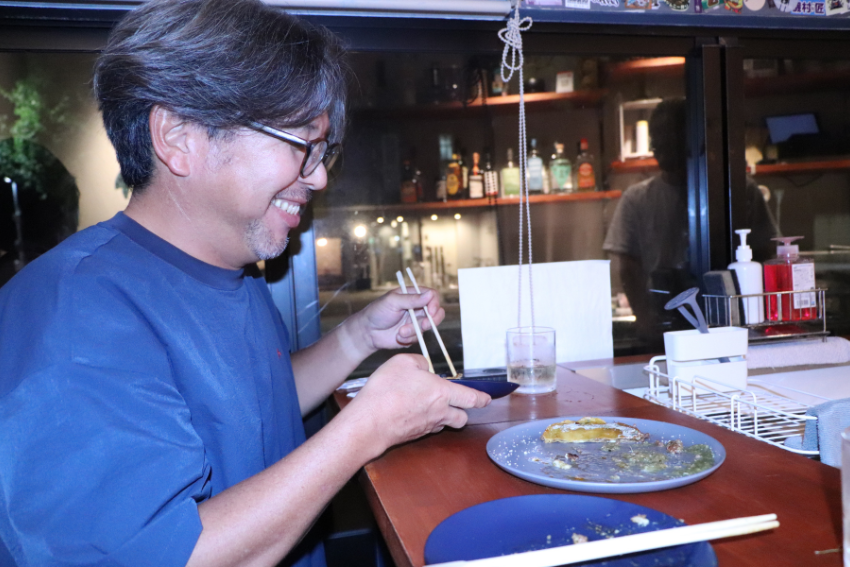
I asked him how many Mexicans visited his place each day, and he told me about 10 on average, which is quite a lot, especially since many come in big groups of friends or family. He also said he receives about 20 Japanese customers daily and the rest are foreigners of other nationalities: Americans, Australians, Germans, French, Dominicans, Salvadorans, Danes, and a few Chinese, all united by the taste of Mexico. I found it really interesting that so many Japanese people visited and were curious about tacos. When I asked why, he said Mexican food has gained huge popularity thanks to the Netflix series “Taco Chronicles.”
Gifts from a satisfied customer
Between chats, tacos and laughter, time flew by and my heart filled with joy after finding Taco Scratch and having that conversation with Keita. On leaving the place, I couldn’t stop smiling about the experience I had just enjoyed. Of course, I returned two more times, eager to taste those tacos again and chat more with my new friend. On my last day in Kyoto, I stopped by to say goodbye and gave him a Mexican flag and a charro hat as a token of my gratitude for his effort and dedication to honoring Mexican culture in such a way. Keita says he would love to return to Mexico and live there someday.
Keita, ありがとうございます
María Ruiz is the Director of Digital Marketing at Mexico News Daily. She enjoys photographing her hometown of San Miguel de Allende in her spare time.
Mexico in Numbers: Agriculture
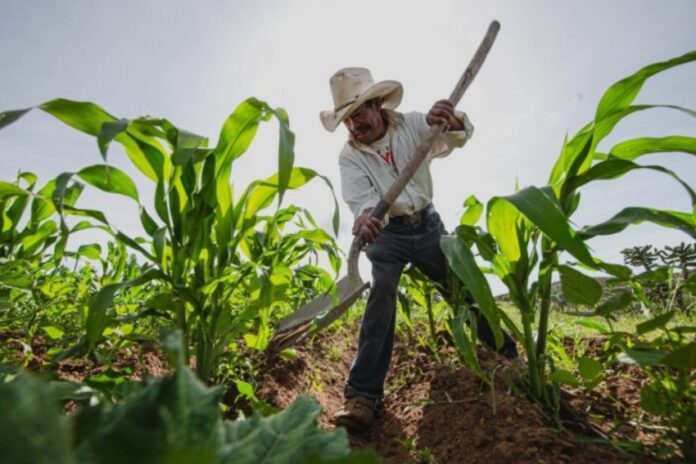
Mexico is a leading global agricultural producer, ranking 11th worldwide. Its diverse geography and climates, ranging from fertile valleys to tropical lowlands and arid plateaus, enable the cultivation of various crops that supply domestic consumers and international markets.
Sector overview
Agriculture has shaped Mexico’s economy, food security and culture for millennia. Staple grains like maize remain central to daily life, while high-value exports such as avocados, berries and tomatoes drive foreign trade earnings.
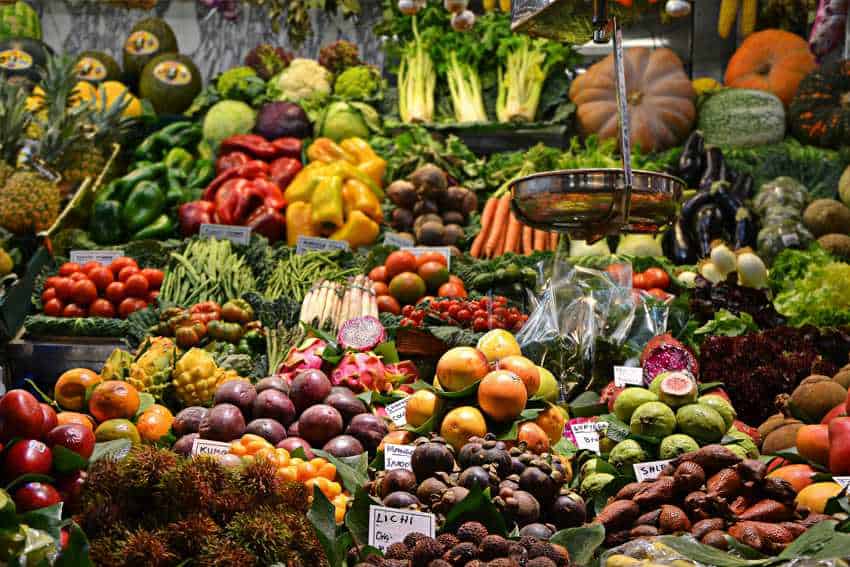
Agriculture contributes 3.8% of gross domestic product (GDP), yet it punches above its weight in trade: Agri-food exports reached US $19.4 billion from January through October 2024. Mexico’s agricultural sector encompasses 49 million acres (20 million hectares), with 47 million acres (19.2 million hectares) harvested in 2024, generating a total production value of 855.8 billion pesos (US $45.36 billion).
Trade agreements — most notably the United States–Mexico–Canada Agreement (USMCA)—have strengthened market access, while new opportunities in Asia are emerging for tequila, coffee and specialty fruits.
The following analysis examines the five most significant crops by production value and volume, highlighting their market performance, pricing trends and economic contributions. Official data is drawn from Mexico’s Agricultural and Fisheries Information Service (SIAP) and the Ministry of Agriculture and Rural Development (SADER).
Challenges
Despite its strengths, the sector faces persistent hurdles:
- Water scarcity: Northern states such as Sonora and Chihuahua are confronting dwindling reservoir levels, threatening irrigation-dependent crops like wheat and corn.
- Climate change: Increased drought frequency and unpredictable rainfall disrupt planting cycles and reduce yields.
- Smallholder vulnerability: More than 70% of Mexican farmers are smallholders with limited access to credit, insurance and modern technologies, leaving them exposed to market volatility and extreme weather.
- Market pressures: Peso appreciation has reduced dollar-denominated returns on exports such as avocados, while global competition is intensifying in key crops like tomatoes and berries.
Innovation
Mexico is addressing these challenges through technology and new business models:
- Water-efficient farming: Drip irrigation, precision agriculture and protected cropping systems (greenhouses and shade houses) are gaining ground, improving yields while conserving water.
- Genetic research: Public and private institutions are developing drought-resistant maize varieties to stabilize production.
- Cooperatives & fair trade: Smallholder cooperatives are helping farmers secure better prices, especially for coffee and beans.
- Urban agriculture: Projects in Mexico City and other major urban centers connect consumers directly with growers, reducing food miles and supporting local economies.
- Sustainable certification: Organic farming and fair-trade certification are expanding, particularly in export-oriented crops such as berries and coffee.
1. Corn: The heart of Mexican cuisine
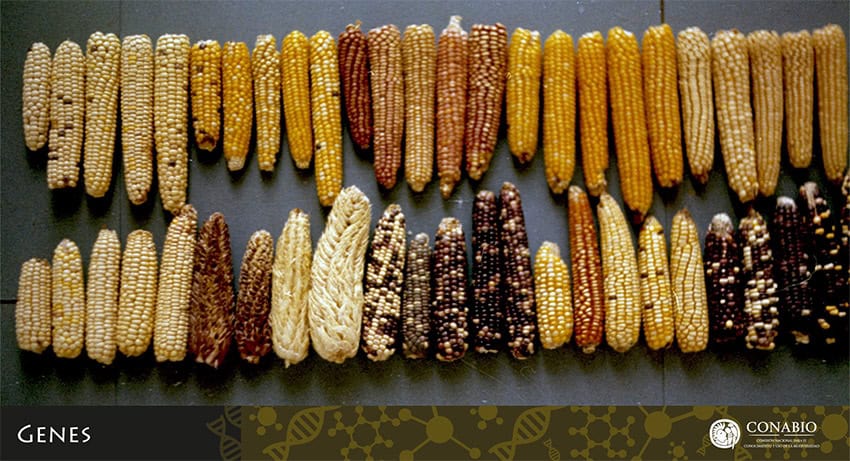
Corn is Mexico’s most valuable agricultural crop, generating 172 billion pesos in production value in 2023. More than a food source, corn is central to national identity. Archaeological evidence traces the domestication of maize in southern Mexico over 9,000 years ago, and millions of small-scale farmers still cultivate native landraces, preserving biodiversity and traditional methods.
- Production: Forecast at 23.5 million metric tons (MMT) for marketing year (MY) 2024-2025, a 16% decrease from the previous year due to drought. Spring–summer cycle production was 18.6 MMT, while fall–winter cycle production contributed 4.9 MMT, a 45% drop due to severe drought in Sinaloa. White corn production reached 18.5 MMT, with Sinaloa contributing significantly. Mexico is on track for white corn self-sufficiency in 2025, with national availability projected to exceed 2 MMT.
- Market prices: The government-guaranteed price for small producers is 5,840 pesos per ton (2025). Prices showed volatility due to drought and production variations, with white corn prices remaining mostly stable or slightly declining between October and December 2024.
- Outlook: MY 2025–2026 forecast: 24.5 MMT, a 7% increase driven by higher local prices and reduced domestic stocks. The Harvesting Sovereignty Program aims to boost white corn production to 25 MMT by 2030.
2. Avocados: Mexico’s ‘green gold’
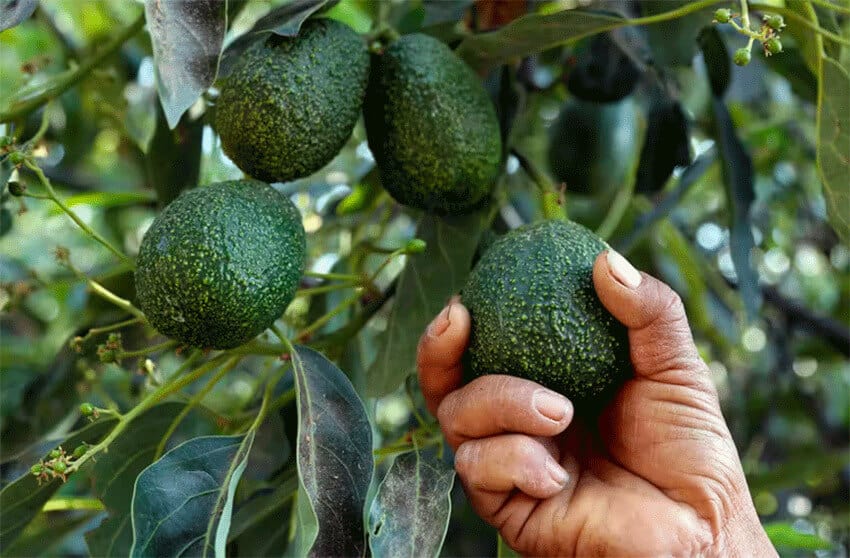
Avocados are Mexico’s second-most valuable crop, with a production value of 60 billion pesos in 2023. Mexico is the world’s largest avocado exporter, with Michoacán dominating global markets.
- Production: 2024 forecast: 2.77 MMT, a 5% increase over 2023 (2.65 MMT), driven by strong export demand, particularly from the U.S. Michoacán: 73% of national output; Jalisco: 12%; State of Mexico: 5%. Planted area: 636,470 acres (257,571 hectares) in 2023, up 2% from the previous year.
- Market prices: Export value decreased 12% in 2023 despite higher volumes due to peso appreciation. Local producers reported lower prices because of smaller average fruit sizes caused by drought and above-average temperatures.
- Outlook: Favorable growing conditions and conversion from traditional crops to high-value avocado orchards, particularly in Jalisco, support near-term growth. Expansion continues, replacing corn, wheat, and pasture areas. Environmental scrutiny on deforestation could influence future planting.
3. Tomatoes: A key export crop
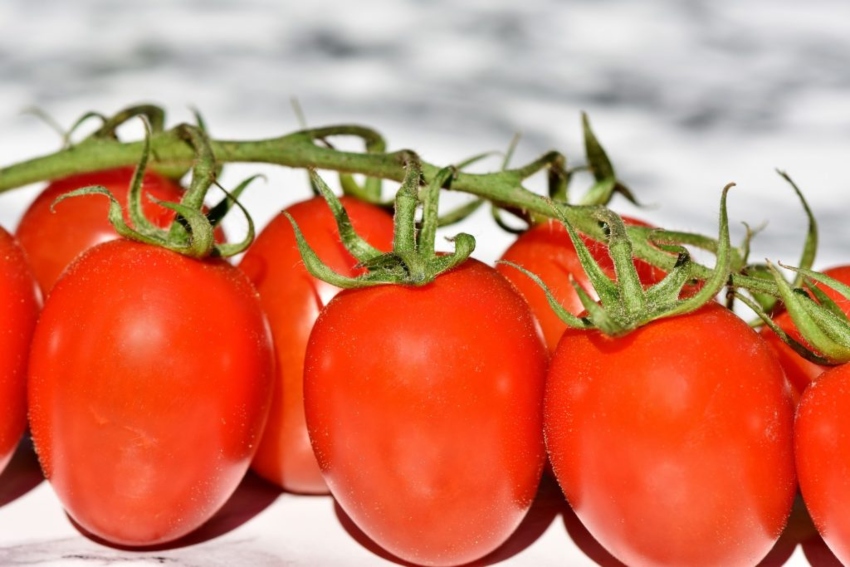
Tomatoes are a major Mexican export, particularly to the U.S., Canada and Europe.
- Production: 2024 forecast: 3.30 MMT, up 2% from 2023 (3.22 MMT), driven by export demand and investments in protected agriculture systems. Leading producers: Sinaloa (22%), San Luis Potosí (13%), Michoacán (7%). Harvested area in 2023: 114,457 acres (46,319 hectares), producing 3.22 MMT.
- Market prices: The U.S. is the top export market, with 1.82 MMT valued at US $2.7 billion in 2023, representing a 1% volume increase and 10% value increase from 2022.
- Outlook: Transition toward greenhouses, shade houses and high tunnels mitigates climate risks. While short-term production may drop, yields and quality are expected to improve over time.
4. Beans: A cultural mainstay
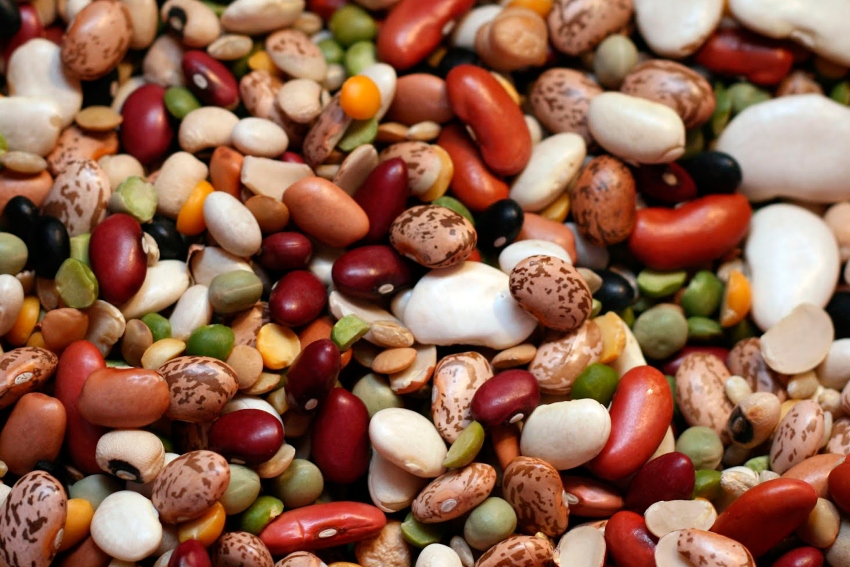
Beans are a staple of Mexican cuisine, important for nutrition and cultural identity.
- Production: Forecast at 1.01 MMT for MY 2024-2025, a 41% rebound from the drought-driven low of 724,000 tons in 2023-2024. Recovery is due to a 32% increase in planted area and improved rainfall. Zacatecas and Sinaloa are primary producers; Sinaloa harvest expected 150,000–180,000 tons, surpassing the internal demand of 100,000 tons.
- Market prices: The government-guaranteed price is 27,000 pesos per ton (2025), the highest among major crops. Imports surged 230% in 2023 to 313,000 tons valued at US $369 million.
- Outlook: President Claudia Sheinbaum’s Prosebien program aims to boost output by 300,000 tons annually, targeting a 30% production increase over six years to reduce imports and achieve food sovereignty.
5. Wheat: A culinary staple

Wheat, introduced during Spanish colonial times, is essential for bread production. It faces significant drought-related challenges, particularly in northwestern states.
- Production: MY 2024–2025: 2.6 MMT, down 25% from the previous year. Winter cycle: 2.53 MMT, affected by prolonged drought and record-low water levels in Sonora and Sinaloa reservoirs.
- Market prices: Government-guaranteed price: 7,600 pesos per ton. To offset reduced domestic production, imports are forecast at 5.7 MMT, up 6%.
- Outlook: MY 2025–2026: forecast 1.7 MMT, down 36%, with imports projected at 6.4 MMT. Farmers are increasingly shifting to less water-intensive crops.
Conclusion
Mexico’s agricultural sector is a global leader, combining rich tradition, diverse crops and strong export performance. Challenges such as water scarcity, climate change, and smallholder vulnerability persist, but innovation, sustainable practices and government programs are strengthening resilience. Balancing heritage, modern technology and global market demand will be key to ensuring Mexico’s continued prominence in agriculture.
As agriculture continues to evolve, access to reliable data and expert knowledge becomes increasingly important. Wikifarmer is an international platform that empowers farmers and agribusiness professionals through three core pillars: the Wikifarmer Marketplace, which connects producers with buyers globally; the Wikifarmer Library, a free knowledge hub with thousands of articles authored by experts; and Wikifarmer Price Insights, which provides up-to-date market intelligence on key crops and commodities. With millions of users worldwide, Wikifarmer combines practical expertise with real-time market data, making it a valuable resource for stakeholders seeking to understand and succeed in the agricultural economy.
Irena Vélez is a journalist at Wikifarmer.com, based in Seville, Spain. She holds a Bachelor’s in Journalism Honours from Carleton University in Ottawa, Canada, and has a background in agricultural reporting. She writes research-based articles on sustainable farming, crop management and rural entrepreneurship, helping make agricultural knowledge accessible to farmers worldwide.
